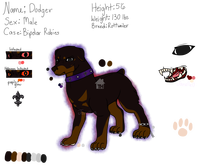Profile
Dodger the rottweiler
He lives in the hood and has an abusive owner who likes to flex him everywhere. The only time Dodger had felt real love was when he was with his mother. He was separated from her and sold to many different owners. His name has always stayed the same, and he has been trained to be a violent aggressive dog for most of his life. But despite that, is a rather shy, submissive, kind dog. He always likes to make friends with other dogs and help humans out the best way he can, despite having to be chained to a tree in a bare backyard for hours alone. Whenever he refuses to hurt anyone or anything by his owner's command, the owner kicks and threatens him with weapons. He'd also gotten several broken and fractured bones from the abuse. Due to this torment, Dodger has become more submissive, and has even showed signs of depression numerous times. He does have many scars and bruises, but they are covered by fur and are difficult to see.
Case Information
The notorious thing about Dodger is that he is infected with a rare form of rabies, called bi-rabies (fictional disease.) The disease is spread by unknown means and is said to be a mutated human sickness, but can only infect animals. Which means that animals that have been or are often around humans are more likely to catch it. At completely random times, usually when the animal is in isolation, the victim of the disease will transform and succumb to the side effects of average rabies. It is unable to be cured, but the longer it goes untreated, the worse the symptoms get for the animal. However, within the period of an hour to 24 hours, the rabies side effects can simmer down quickly, and the animal will return to its normal state. This behavior is called a blue shift, and is what makes it bipolar. During shifts, the animal's durability, dexterity and intelligence notably increase. Depending on how accustomed the disease is to the body, it is a known fact that those mental and physical statistics can rise much higher than normal.
The sickness isn't totally uncontrollable, however. Experts have discovered that after at least 8 months of infection, the animal may find the shift controllable, but that is also a rare occurrence. It takes a calm state of mind toward oneself, and treating the disease as more of an advantage in any way. Therefore, learning to control shifting will take concentration, but it's more than simple enough for subjects to achieve. Once an animal gains control, it is free to decide if it wants to rid itself of the disease by never shifting, but they cannot truly get it out of their systems. In addition, when an animal has gained control, that control is very likely to be partial. When the animal's blood pressure gets too high, it shifts out of control. The higher the heartbeat, the more intense the side effects become. This is called a red shift. It can, however, be prevented if the blood pressure is calmed quickly enough, and this may not apply to all infected subjects. Once in control, the animal may infect others via salivary contact by its will. Meaning that during a shift, the animal can excrete cells of the disease through the saliva if it desires.
Physical appearance during shifts differs from different colored eyes, blood, and fluids. Every subject has shown drastic increases in aggression, and frothing around the mouth. Health of the animal seems to get worse with treatment, but authorities classify that in hopes of 'putting down' as many infected animals as possible. It's impossible to determine if an animal is infected with bipolar rabies by physical appearance, and cannot be detected in the blood. It can be sniffed out by few species, but experts have some difficulty performing that test.
In Dodger's case, his dexterity is most affected. During a shift, he's fast enough to dodge bullets at close range. In other abilities, his jaws are strong enough to bite and rip through many materials, and has a high durability so can ram himself through sturdy walls without recoil. His body is immune to toxic materials and chemicals, so when injected or inhaled, bad chemicals are immediately filtered back out of the body. He can climb trees with ease and understand human speech. His motor skills are developed to that of a young human's. His scent ability has increased to now being able to smell anything through any material in the vicinity of a 32 km radius, which translates to 19.8 miles away.
Dodger also has an addition never seen before; he seems to become the most crazed in the month of October, Hallows Eve, and Halloween Day! Or rather, night. Dodger loves the night much more than the day, and loves to communicate with other dogs, although things don't end too well most times. When October comes around, his usual submissive self turns into a totally different dog. A wild, hyper-active one. Hyper activity is said to mix terribly with birabies, in the sense that the blood pressure is always higher than usual, and excitement in animals can lead to unfortunate events.
Dodger's shift appearance changes in October. He becomes much stronger and aggressive in his shifts, and the color of the eyes changes from the common pink and black to red sclera, black iris, and very reflective neon orange pupils.
Once, a person he confronted shot at him in fear, and to this day, that person is missing. What really happened was after Dodger evaded the shots, he ran up and attacked from the side, knocking down his target. Then he gave a fatal bite to the neck. The attack was impossible for other people to hear or see other than a couple common gunshots and yelling. But the authorities were never called until the next morning. Dodger had carried the body over to a hideout where other stray dogs could make use of it. Only the bullets were found on the road. Scent dogs could smell Dodger and the birabies, and we're too afraid to cooperate any further than a few sniffs. The search was suspended.
Dodger has a buddy deep in the woods whom he likes to visit often. He's a leopard named Benji, who is infected with a newly discovered higher level of birabies; tri-rabies. In tri-rabies, there are three different stages. Normal, infected, and perinormal. Perinormal is an invisible, more effective version of the infected stage. The animal appears normal, but is in-fact in a shift. But automatically, tri-rabies is controllable. Dodger and Benji are always there for each other. Benji also comes from being sold to different owners, but many more than Dodger. He is a five year-old adult, and has had his case for two years. Ever since he got infected, he rebelled against the humans, broke out of his cage, and ran into the wild. Then he came across infected Dodger. They could smell each other, and weren't in their shifts so didn't start a fight. Then they started to discover that their lives were very much similar. Every couple days, they talk and talk while watching the forest, wondering how many more like them are out there.



